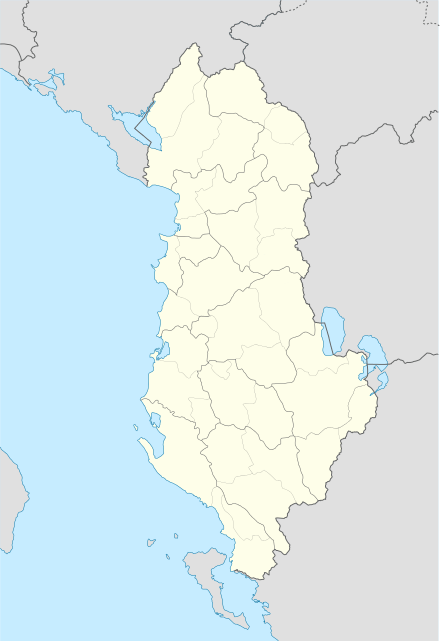Xarrë
Xarrë (Albanian pronunciation: IPA: [d͡zar] or IPA: [d͡zarə], Aromanian: Ḑara;[1] Greek: Τζάρα, Tzára) is a village and a former municipality in the Vlorë County, southern Albania. At the 2015 local government reform it became a subdivision of the municipality Konispol.[2] The population at the 2011 census was 4,263.[3] The municipal unit consists of the villages Xarrë, Mursi, Shkallë and Vrinë.[4]
Xarrë | |
|---|---|
 Xarrë | |
| Coordinates: 39°44′N 20°3′E | |
| Country | |
| County | Vlorë |
| Municipality | Konispol |
| Population (2011) | |
| • Municipal unit | 4,263 |
| Time zone | UTC+1 (CET) |
| • Summer (DST) | UTC+2 (CEST) |
| Vehicle registration | SR |
Municipal demographics
The village of Xarrë is inhabited by an Orthodox Albanian majority, Muslim Albanian Chams (200) that arrived from northern Greece in the 1920s and 1940s, a combined population of Aromanians and Greeks (50) and some Romani.[5][6] Mursi is inhabited an Orthodox Albanian majority, alongside a few Muslim Albanians and Greeks.[5][6] Shkallë is inhabited by an Aromanian majority, alongside a few Muslim Albanians and Greeks and also contains a few families of Muslim Romani originally from Filiates, Greece who following the exodus of the Cham Albanians in 1944-1945 settled in the region.[5][7] Vrinë is a new village established during the communist period and is populated by Muslim Albanians (400), Orthodox Albanians (318) and Greeks (300).[5]
References
- Kahl, Thede (1999). Ethnizität und räumliche Verbreitung der Aromunen in Südosteuropa. Universität Münster: Institut für Geographie der Westfälischen Wilhelms. p. 146. ISBN 3-9803935-7-7.CS1 maint: ref=harv (link) "Ḑara"
- Law nr. 115/2014
- 2011 census results
- Greece – Albania Neighbourhood Programme Archived March 27, 2012, at the Wayback Machine
- Kallivretakis, Leonidas (1995). "Η ελληνική κοινότητα της Αλβανίας υπό το πρίσμα της ιστορικής γεωγραφίας και δημογραφίας [The Greek Community of Albania in terms of historical geography and demography." In Nikolakopoulos, Ilias, Kouloubis Theodoros A. & Thanos M. Veremis (eds). Ο Ελληνισμός της Αλβανίας [The Greeks of Albania]. University of Athens. p. 51. "Ε Έλληνες, ΑΧ Αλβανοί Ορθόδοξοι Χριστιανοί, AM Αλβανοί Μουσουλμάνοι, ΤΣ Τσάμηδες, Β Βλάχοι, Μ Μικτός πληθυσμός”; p.52. "XARRE TZAPA 2085 AX + αμ (200) + ε/β (50); MURSI ΜΟΥΡΣΙ (ΜΟΥΡΤΣΙΑ) 1984 AX + αμ + ε; VRINE BPINA (νέο) 1018 M (400 AM+ 318 ΑΧ+ 300 E); SHKALLE ΣΚΑΛΛΑ 619 Β + αμ + ε"
- Kretsi, Georgia (2005). "The uses of origin: Migration, Power-struggle and Memory in southern Albania". In King, Russell; Mai, Nicola; Schwandner-Sievers, Stephanie (eds.). The New Albanian Migration. Brighton-Portland: Sussex Academic.CS1 maint: ref=harv (link) pp. 197-198. The first village, Xarrë, contains a mixed population in regard to confession and language.[3] The village is about 15 km from the Albanian-Greek border crossing point (for pedestrians) of Qafë Bota and around 30 km from the district capital, Sarandë. The second community, Mursi, consists of a rather homogeneous population in terms of religious affiliation and language (Christian and Albanian speaking) and is located just 1 km away from Xarrë."; p. 210. "[3]. In Xarrë the relevant groups were Albanian-speaking Christians, Çam people (or Chams - the Albanian speaking minority settled in northern Greece/Epirus in the 1920s and 1940s), Vlachs (cattle breeders, speaking a Latin-based language), Roma, and some members of the Greek minority."
- Baltsiotis, Lambros (2015). "Balkan Roma immigrants in Greece: An initial approach to the traits of a migration flow", International Journal of Language, Translation and Intercultural Communication. 1. (1): 5. " In general terms, it seems that previous ties of any kind with Greece facilitate not only the migration but also a more permanent way of living in the country. This is the case with the Muslim Roma of Filiati in Thesprotia who, following the expulsion of the Muslim Albanian Chams from Greece in 1944-1945, were settled in the village of Shkallë, Sarandë in Albania. The majority of the families, more than fifteen, gradually settled in Greece.

